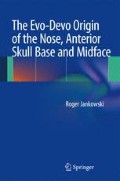Abstract
Cranial placodes (Holland and Holland 2001; Bassham and Postlethwait 2005) are specialized areas of the head ectoderm of vertebrate embryos that typically first become apparent as patches of thickened, columnar epithelial cells. Placodes, with the exceptions of the neurohypophyseal and lens placodes, are neurogenic, differentiating into neurons as well as other cell types. Placode-derived tissues make a significant contribution to the visual, olfactory, acoustico-lateralis, and gustatory systems of all living vertebrates.
Access this chapter
Tax calculation will be finalised at checkout
Purchases are for personal use only
Notes
- 1.
See Fig. 2.5 that shows this proximity of the two placodes during lamprey embryogenesis.
References
Bassham S, Postlethwait K (2005) The evolutionary history of placodes: a molecular genetic investigation of the larvacean urochordate Oikopleura dioica. Development 132(19):4259–4272
Bollner T, Holmberg K et al (1986) A rostral sensory mechanism in Oikopleura dioica (Appendicularia). Acta Zool (Stoc) 67(4):235–241
Canestro C, Bassham S et al (2005) Development of the central nervous system in the larvacean Oikopleura dioica and the evolution of the chordate brain. Dev Biol 285:298–315
Churcher A, Taylor J (2009) Amphioxus (Branchiostoma floridae) has orthologs of vertebrate odorant receptors. BMC Evol Biol 9(242):1–10
Delsuc F, Tsagkogeorga G et al (2008) Additional molecular support for the new chordate phylogeny. Genesis 46(11):592–604
Gans C, Northcutt R (1983) Neural crest and the origin of vertebrates: a new head. Science 220:268–274
Glardon S, Callaerts P et al (1997) Conservation of Pax-6 in a lower chordate, the ascidian Phallusia mammillata. Development 124:817–825
Holland L, Holland N (2001) Evolution of neural crest and placodes: amphioxus as a model of the ancestral vertebrates. J Anat 199:85–98
Lacalli T (2002) Sensory pathways in amphioxus larvae I. Constituent fibres of the rostral and anterodorsal nerves, their targets and evolutionary significance. Acta Zool (Stoc) 83:149–166
Lacalli T (2005) Protochordate body plan and the evolutionary role of larvae: old controversies resolved? Can J Zool 83:216–224
Lacalli T (2008) Basic features of the ancestral chordate brain: a protochordate perspective. Brain Res Bull 75:319–323
Lacalli T, Hou S (1999) A reexamination of the epithelial sensory cells of amphioxus (Branchiostoma). Acta Zool (Stoc) 80:125–134
Lacalli T, Gilmour T et al (1999) The oral nerve plexus in amphioxus larvae: function, cell types and phylogenetic significance. Proc Biol Sci 266:1461–1470
Li H, Tierney C et al (1997) A single morphogenetic field gives rise to two retina primordia under the influence of the prechordal plate. Development 124:603–615
Lohmann H (1899) Das Gehaäuse des Appendicularien, sein Bau, seine Funktion und seine Entstehung. Schr Naturw Ver Schlesw.-Holst 11:345–407
Martini E (1909) Studien über die Konstanz histologischer Elemente I. Oikopleura longicanda. Z wiss Zool 92:563–626
Mazet F, Hutt J, Mazet F, Hutt J et al (2005) Molecular evidence from Ciona intestinalis for the evolutionary origin of vertebrate sensory placodes. Dev Biol 282:494–508
Satoh G (2005) Characterization of novel GPCR gene coding locus in amphioxus genome: gene structure, expression, and phylogenetic analysis with implications for its involvement in chemoreception. Genesis 41:47–57
Stach T (2008) Chordate phylogeny and evolution: a not so simple three-taxon problem. J Zool 276:117–141
Stach T, Turbeville J (2004) The role of appendicularians in chordate evolution - a phylogenetic analysis of molecular and morphological characters, with remarks on ’neoteny-scenarios. In: Gorsky G, Youngbluth M, Deibel D (eds) Response of marine ecosystems to global change: ecological impact of appendicularians. Editions des Archives Contemporaines, Paris, pp 9–26
Varga Z, Wegner J et al (1999) Anterior movement of ventral diencephalic precursors separates the primordial eye field in the neural plate and requires cyclops. Development 126:5533–5546
Wicht H, Lacalli T (2005) The nervous system of amphioxus: structure, development, and evolutionary significance. Can J Zool 83:122–150
Author information
Authors and Affiliations
Rights and permissions
Copyright information
© 2013 Springer-Verlag France
About this chapter
Cite this chapter
Jankowski, R. (2013). Phylogenetic Origins of the Visual and Olfactory Organs. In: The Evo-Devo Origin of the Nose, Anterior Skull Base and Midface. Springer, Paris. https://doi.org/10.1007/978-2-8178-0422-4_15
Download citation
DOI: https://doi.org/10.1007/978-2-8178-0422-4_15
Published:
Publisher Name: Springer, Paris
Print ISBN: 978-2-8178-0421-7
Online ISBN: 978-2-8178-0422-4
eBook Packages: MedicineMedicine (R0)

